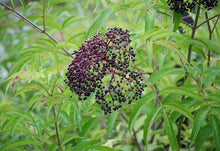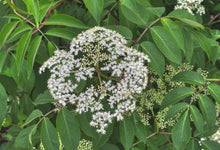It's hard to know where to start when extolling the many fantastic traits of Elderberry. Its tiny, fragrant flowers are borne in giant, showy clusters in early summer and can attract hundreds of pollinators on a sunny day. These flowers give way to spectacular masses of dark fruit, providing a feast for birds of all kinds. If you're lucky enough to get to the berries first, you can concoct elderberry jellies, pies, or even wine. The deer don't like it, it responds well to hard pruning, and its compound leaves provide interesting texture. The only caveat is that Elderberry is not necessarily a plant for a small garden. Instead, use it as a hedge or living fence, plant it along a wet border, create a backdrop for your pond or stream, or fill in that wet, sunny ditch. Let it sucker and spread, and watch as it supports all of your treasured backyard critters.
Conditions: Full sun to part shade; medium to wet soil
Size: 5' - 12' tall, 6'-10' spread
Zone: 3 - 9
Wildlife Value: Flowers highly attractive to native bees, hoverflies, long-horned beetles, tumbling flower beetles and many other pollinators; fruits beloved by birds; larval host for Elderberry longhorn beetle
Photos: Dave Korbonits






